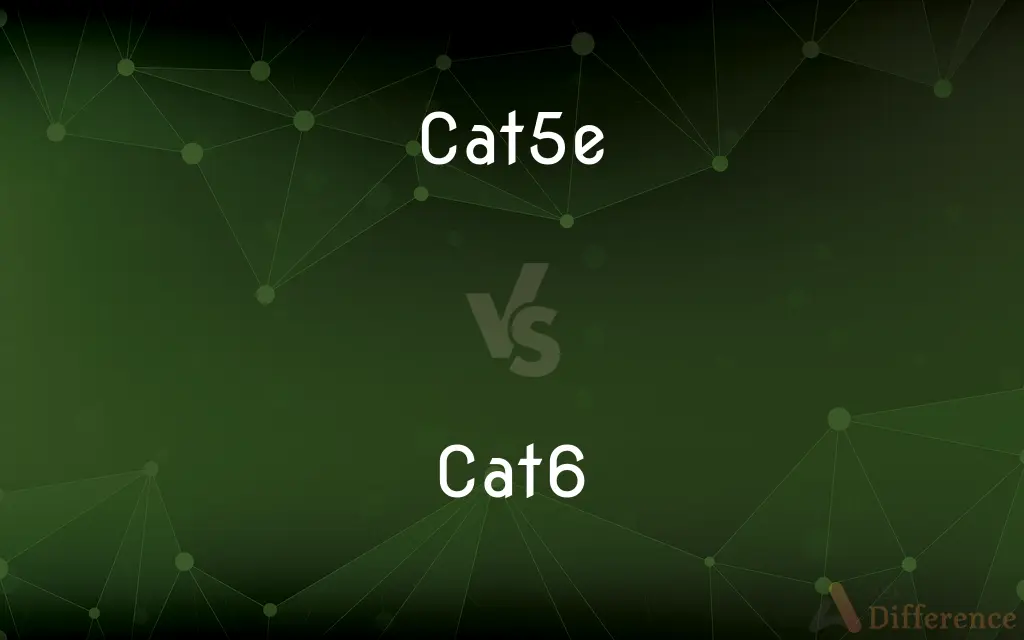Cat5e vs. Cat6 — What's the Difference?
By Tayyaba Rehman — Published on December 7, 2023
Cat5e and Cat6 are Ethernet cable standards; Cat5e supports up to 1 Gbps networks, while Cat6 supports up to 10 Gbps in certain conditions.

Difference Between Cat5e and Cat6
Table of Contents
ADVERTISEMENT
Key Differences
Cat5e and Cat6 are both standards for Ethernet cables used in wired networks. The progression from Cat5e to Cat6 represents an evolution in performance, specifications, and capabilities.
Cat5e, standing for "Category 5 enhanced," was an improvement over its predecessor, Cat5. Cat5e is designed to support speeds up to 1 Gbps, making it suitable for Fast Ethernet and Gigabit Ethernet applications. It also reduces the interference that can interrupt network speeds, ensuring a more stable connection.
Cat6, or "Category 6," takes performance a step further. This cable is designed to support Gigabit Ethernet networks, but it can also support up to 10 Gbps, albeit with a limited distance of up to 55 meters. With tighter specifications, Cat6 offers higher performance and fewer cross-talks than Cat5e.
In the context of an everyday user, the difference between Cat5e and Cat6 might not be immediately noticeable. However, for businesses or setups requiring high data transfer rates over a network, Cat6 might be the more advantageous choice due to its enhanced capabilities.
When deciding between Cat5e and Cat6, it's essential to consider the specific needs of the network. For most home users, Cat5e might suffice. But for future-proofing or for networks requiring high data transfer rates, Cat6 is often the recommended choice.
ADVERTISEMENT
Comparison Chart
Max Data Rate
Up to 1 Gbps
Up to 10 Gbps (limited distance)
Frequency
Up to 100 MHz
Up to 250 MHz
Interference
Reduced interference compared to Cat5
Even less interference than Cat5e
Usage
Suitable for most home networks
Preferred for business & high-performance networks
Cost
Typically less expensive
Slightly more expensive due to enhanced specs
Compare with Definitions
Cat5e
Supports network speeds up to 1 Gbps.
With Cat5e, my office sustains a consistent Gigabit Ethernet connection.
Cat6
A high-performance Ethernet cable standard.
The office upgraded to Cat6 to meet its growing data demands.
Cat5e
Designed to reduce network interference.
Upgrading to Cat5e helped minimize data interruptions in our setup.
Cat6
Features tighter winding and is often shielded.
Cat6's design helps it minimize interference and cross-talk.
Cat5e
Has a frequency up to 100 MHz.
The Cat5e's 100 MHz frequency ensures stable data transmissions for everyday use.
Cat6
Can support speeds up to 10 Gbps under certain conditions.
Our data center uses Cat6 for its potential 10 Gbps throughput.
Cat5e
An enhanced version of Cat5 Ethernet cable.
My home network uses Cat5e cables for its affordability and efficiency.
Cat6
Ideal for business and advanced networking setups.
For our server connections, we trust Cat6 for its superior performance.
Cat5e
Suitable for most residential applications.
Most modern homes are wired with Cat5e for reliable internet access.
Cat6
Operates at frequencies up to 250 MHz.
The increased 250 MHz frequency of Cat6 ensures faster data transfers in our network.
Common Curiosities
Which is more expensive, Cat5e or Cat6?
Cat6 is generally more expensive than Cat5e due to its enhanced specifications.
Is there a noticeable speed difference between Cat5e and Cat6 for home use?
For most home users, the difference might not be significant, but Cat6 offers potential future-proofing.
How can I identify Cat5e and Cat6 cables physically?
Both cables usually have their category printed on the outer sheath.
For a new home network, should I install Cat5e or Cat6?
If budget allows, Cat6 is a future-proof choice, but Cat5e is often sufficient for standard home use.
Are there any categories higher than Cat6?
Yes, Cat6a, Cat7, and Cat8 are higher categories with increased performance.
Why would I choose Cat5e over Cat6?
Cat5e is usually sufficient for many home networks and is often more affordable.
Can I use Cat6 in place of Cat5e without any changes?
Yes, Cat6 is backward compatible with Cat5e hardware, but to fully utilize Cat6's capabilities, compatible hardware is recommended.
How far can I run a Cat5e or Cat6 cable?
Both can typically run up to 100 meters, but for 10 Gbps speeds on Cat6, it's limited to 55 meters.
Is Cat6 thicker than Cat5e?
Generally, yes. Cat6 often has thicker wires and more insulation.
Can Cat6 support 10 Gbps over long distances?
No, Cat6 supports 10 Gbps up to 55 meters. For longer distances at 10 Gbps, Cat6a or higher is needed.
Do both Cat5e and Cat6 use the same connectors?
They both typically use the RJ45 connector, but there are Cat6-specific connectors for optimal performance.
Can I mix Cat5e and Cat6 in a network?
Yes, but the network will operate at the speed of the slowest component.
How do Cat5e and Cat6 handle interference?
Cat5e reduces interference compared to Cat5, and Cat6 further minimizes it with tighter twists and often shielding.
Are Cat5e and Cat6 cables shielded?
Cat6 cables are often shielded, while Cat5e can be either shielded or unshielded.
Do Cat5e and Cat6 differ in color?
No, the color of the outer sheath doesn't determine the category. Always check the printed information.
Share Your Discovery

Previous Comparison
Cat6 vs. Cat6a
Next Comparison
Pour Homme vs. Eau De ToiletteAuthor Spotlight
Written by
Tayyaba RehmanTayyaba Rehman is a distinguished writer, currently serving as a primary contributor to askdifference.com. As a researcher in semantics and etymology, Tayyaba's passion for the complexity of languages and their distinctions has found a perfect home on the platform. Tayyaba delves into the intricacies of language, distinguishing between commonly confused words and phrases, thereby providing clarity for readers worldwide.












































